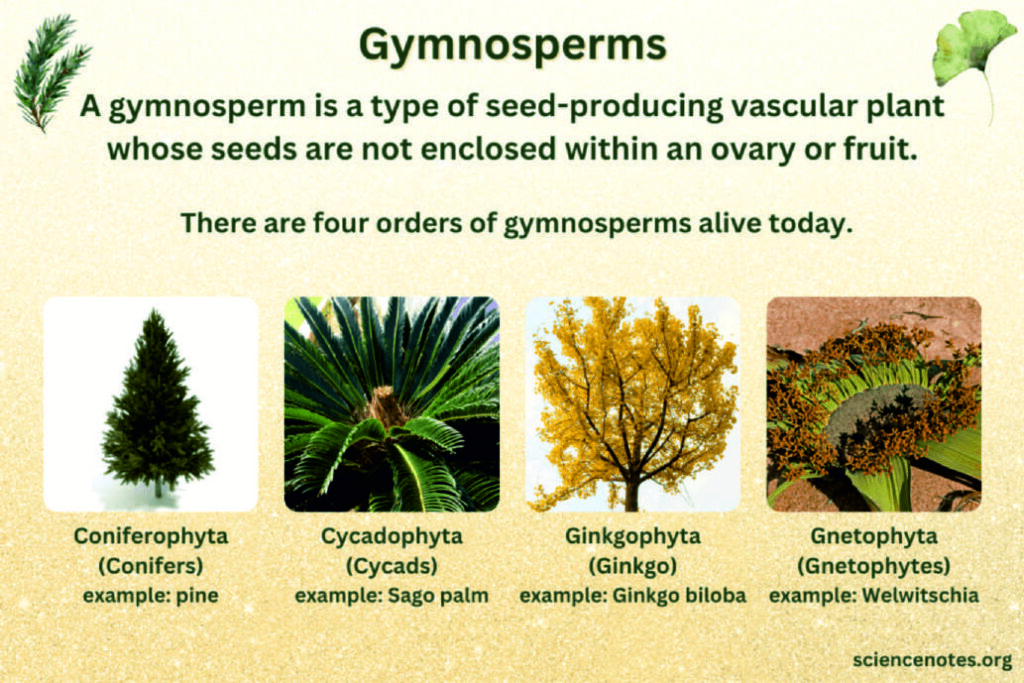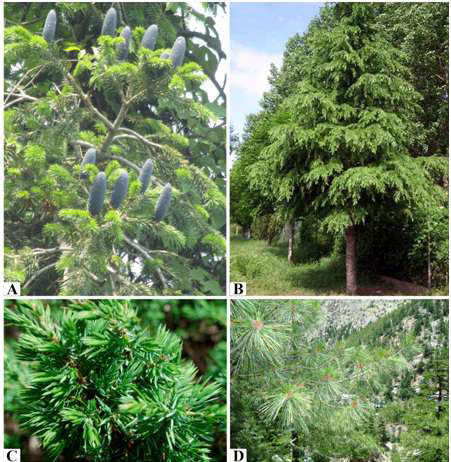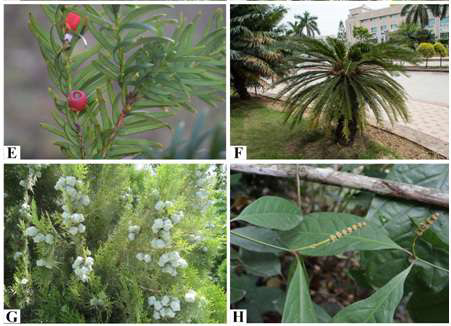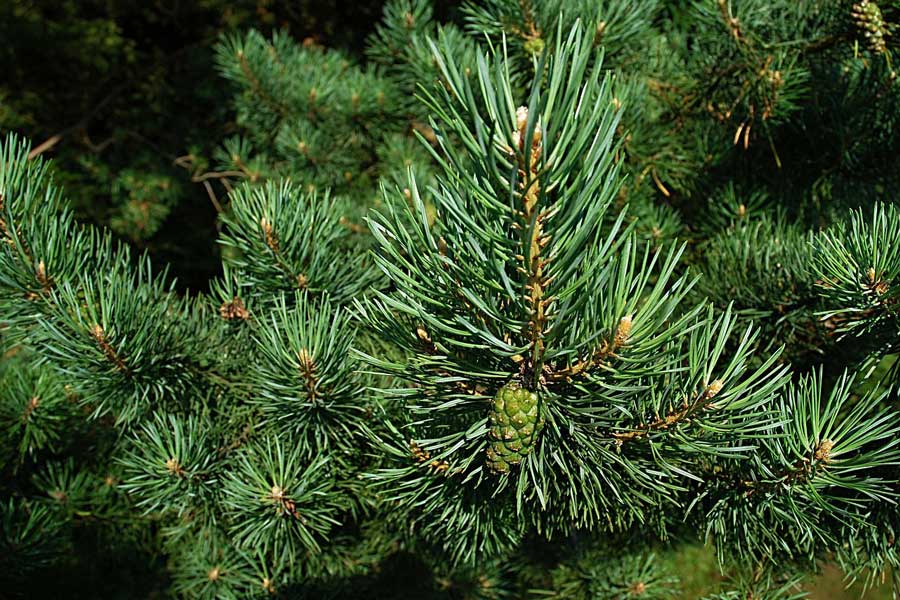ANCIENT GIANTS: THE ETERNAL TRIUMPH OF GYMNOSPERMS
-Acharya Balkrishnaa, Sunita Bishta, Uday Bhan Prajapatia, Anupam Srivastavaa
Gymnosperms, often referred to as ‘naked seed’ plants, are a captivating and remarkable group of species, known for their substantial medicinal and economic importance. Over the course of evolution, these non-flowering plants adapted by developing cones as specialized structures for reproduction. They hold immense research significance, as phylogenetic analyses reveal that they are a sister clade to angiosperms, the dominant plant group of today. Moreover, fossil evidence and evolutionary trends highlight a dynamic interplay between these two groups, showing that the rise of one often corresponds to the decline of the other, and vice versa.

Gymnosperms, once the most dominant and widespread group of plants, surpassing angiosperms in proliferation, are now among the most threatened plant groups in the current anthropocene era. These valuable plants have undergone numerous changes over the course of evolution, influenced by both climatic and environmental factors. Those that successfully adapted over time have managed to survive, while those unable to cope with changing conditions have become extinct (Macrotaeniopteris, Ginkgoites and Buriadia). Today, their presence has significantly diminished, with only four remaining orders-Cycadales, Ginkgoales, Coniferales, and Gnetales-comprising approximately 1,081 species generally inhabiting higher elevations and latitudes. In contrast, angiosperms have flourished, spanning 64 orders and encompassing nearly 350,000 species (Scutt, 2018). Although their numbers are significantly lower compared to angiosperms, the surviving gymnosperms demonstrate remarkable adaptability and resilience. Their ability to endure even the harshest conditions reflects their strength and determination to persist through time. In the geological time scale, conifers were the first to originate, followed by Cycadales and Ginkgoales in the Permian period, while Gnetales emerged later in the Triassic period among all extant gymnosperm orders. The gradual decline of these plant groups created opportunities for the emergence and rapid expansion of angiosperms during the Cretaceous period (Singh et al., 2018). In case of angiosperms advanced reproductive strategies and anatomical and morphological adaptations proved beneficial factors for their establishment.

Gymnosperms have endured cycles of mass extinction, followed by phases of radiation and decline. Scientists have sought to understand the reasons behind their decreasing diversity over time. While some suggest a slow rate of speciation as a contributing factor in gymnosperms decline, the most widely accepted explanation is extinction driven by changing environmental conditions on Earth. Another unanswered question and current topic of ongoing debate is whether modern gymnosperms are relic species that survived the Cretaceous-Paleogene (K-Pg) mass extinction or if they are the result of more recent extinction events and speciation processes.
Of the total extant gymnosperms known till date conifers are the largest and most evolved group so far. Currently, conifers are the most diverse group with around680 species pan-globally distributed followed by Cycadales with around 300 species and Gnetales with around 100 species (Singh, et al., 2018). Ginkgoales, in contrast, is represented by a single surviving species, Ginkgo biloba. The present-day distribution of gymnosperms is closely linked to the geological history of Pangea, the super continent that began breaking apart during the Jurassic period-a time when gymnosperms were abundant. As Pangea split into Laurasia and Gondwana, and these landmasses further fragmented into separate continents with diverse environmental conditions, gymnosperms adapted to different regions, shaping their current global distribution. This continental breakup may have also played a role in the radiation of angiosperms and the subsequent decline of gymnosperms due to changing environmental conditions.

Table 1: Some common Gymnosperms, their etymology and uses.
| S. No. | Family | Botanical name | Etymology Genus epithets | Etymology Species epithet | English Name | Hindi Name | Common/ Medicinal Uses |
| 1 | Araucariaceae | Araucaria cunninghamii Mudie | Named after Arauco Province in Central Chile | Name given of in the honour Allan Cunningham (1791-1839) | Hoop Pine | Bunya Tree | Ornamental & furniture |
| 2 | Cephalotaxaceae | Cephalotaxus griffithii Hook.f. | Derived from Greek word kephale means ‘a head’ and the genus Taxus means ‘yew’ | Name given in the honour of William Griffith | Plum Yew or Cow Tail Pin | Tinya | Anticancer activity |
| 3 | Cupressaceae | Platycladus orientalis Franco (L.) | Derived from the Greek words platys means ‘broad, flat and klados means ‘branch’ | Derived from Latin word orientalis means ‘eastern, oriental, of the East’.! | Green Giant | Мограnkhi | Antiasthmatic, antibacterial, antipyretic, antitussive, aperient, astringent, diuretic |
| 4 | Cupressaceae | Cupressus torulosa D.Don ex Lamb. | Derived from Greek word kuparissos, kyparissos or Akkadian kupuru, kupru means ‘bitumen’ and kuppuru means ‘purify, to clean’ | Derived from Latin word torulosa means muscular, swollen or thickened at intervals, tufted | Himalayan Cypress | Surai | As incense & general construction. |
| 5 | Cupressaceae | Juniperus communis L. | Derived from the classical Latin name juniperus means ‘the juniper tree’ | Derived from Latin word communis means common. | Common or Ground Juniper | Jhora, Billa, Bhitaru | As Fruit, coffee. condiment, tea, antiseptic, in aromatherapy, carminative. tonic, diaphoretic, diuretic. rubefacient and stomach ache |
| 6 | Cycadaceae | Cycas revoluta Thunb. | Derived from Greek word koikas (name used by Theophratus for an unknown palm) which was later called as kykas and then Cycas | Derived from Latin word revolutus which means ‘rolled’, referring to the revolute margins of the leaflet | Sago palm | Sabudaпа | Astringent, in cancer treatment, diuretic, emmenagogue, expectorant, tonic |
| 7 | Ginkgoaceae | Ginkgo biloba L. | Based on ancient Japanese ginkyo which is derived from gin means ‘silver’ and kyo means ‘apricot’ | Derived from Latin words biloba which means lobed; referring two lobed shape of the leaves | Maiden Hair Tree | Ginkgo | Treating dementia, antioxidant, radioprotective agent |
| 8 | Pinaceae | Abies pindrow (Royle ex D.Don) Royle | Derived from the Latin word abies, which refers to the ‘silver fir’ | Name based on West Himalayan name | West Himalayan Fir or Low Level Fir | Raga or Righa | Furniture, fuel, construction purpose |
| 9 | Pinaceae | Abies spectabilis (D.Don) Mirb. | Derived from the Latin word abies, which refers to the ‘silver fir’ | Derived from Latin word spectabilis means ‘admirable, notable, showy | East Himalayan fir, Himalayan Fir, and Webb fir | Talispatra | Treatment of asthma, bronchitis and cold. For construction and fuel |
| 10 | Pinaceae | Cedrus deodara (Roxb. ex D.Don) G.Don | Derived from Greek word kedros referring to various species of Cedrus | Name based on Indian vernacular name | Himalayan Cedar | Deodar, Diar | Its Cedar wood oil, for ulcers and skin diseases, insecticidal and antifungal properties |
| 11 | Pinaceae | Picea smithiana (Wall.) Boiss. | Based on classical name for the spruces | Name given in the honour of James Edward Smith (1759-1828) | West Himalayan Spruce | Kala Chiulu | Condiment, gum, tea |
| 12 | Pinaceae | Pinus roxburghii Sarg. | Derived from Latin ‘Pinus’ means pines | Name given in the honour of William Roxburgh (1751-1815) | Pine (Himalayan long needle pine) | Chir | Antiseptic. diaphoretic, diuretic. rubefacient, stimulant, vermifuge |
| 13 | Pinaceae | Pimus wallichiana A. B. Jackson | Derived from Latin ‘Pinus’ means pines | Name given in the honour of Nathaniel Wallich (1786-1854) | Himalayan Blue Pine | Chilla, Chiulu | Used in construction. carpentry. Resin is used for wound healing, gonorrhoea and as antiseptics |
| 14 | Taxaceae | Taxus contorta Griff | Derived from Latin name Taxus for the yew tree | Derived from Latin word contorta means ‘twisted, bent, intricate’ | Common Yew | Thuner | As tea, antispasmodic, cancer treatment, cardio tonic, diaphoreticd narcotic, emmenagogue, expectorant, taxol has shown exciting potential as an anti-cancer drug |
| 15 | Taxodiaceae | Cryptomeria japonica (Thunb. ex L.f.) D.Don | Derived from Greek words krypto means ‘to hide’, kryptos means ‘hidden’ and meris means ‘a portion, part | Name based on the country Japan | Japanese Cedar | Sugi | Treatment of gonorrhoea |
| 16 | Taxodiaceae | Taxodium mucronatum Ten | Resembling the genus Taxus and the Greek word oides. means ‘resemblance’ | Derived from Latin word mucronatum means ‘mucronate, with a hard sharp-pointed tip’, refers to apex of the leaves | Marsh Cypress (Montezuma Bald Cypress) | Termite resistant wood | |
| 17 |
Medicinally these plants are very valuable and are source of various drugs which are used in treatment of various diseases throughout the world. Various species have been used in modern as well as traditional system of medicine by doctors and local practitioners. These are used in treating cancer and tumor, inflammations or swellings, infections, hypertension, diabetes, stomach and other gastrointestinal ailments and their symptoms like abdominal pain, indigestion, bloating and other digestive disorders. One of the highly effective anti-cancerous drug Paclitaxel (Taxol) used in chemotherapy for treatment of cancer is extracted from the Taxus. Another compound Leelamine extracted from Pine also acts as anti-cancerous agent (Gowdaet al., 2017). Various ancient literature like Susruta Samhita and Charak Samhita and traditional medicinal system like Siddha and Ayurveda also mentions the use of gymnosperms in treatments of diseases and preparations of various formulations. Abies spectabilis known as Talisa in Siddha and Ayurveda is used in treating respiratory ailments. Similarly, Cedrus deodara is used in treatments of urinary disorders and associated symptoms along with wound and cuts. Resin from Pinus roxburghii is used for joint pain, skin diseases and respiratory ailments. Along with medicinal uses gymnosperms have many other traditional uses. Starch isolated from the stem of Cycas circinalis is used in making ‘sago or sabudana’, sun dried seeds are used to make flour (Singh and Singh, 2011).Cedrus deodara and Abies pin drow wood is used in making furniture and for construction purposes. Few species of Cycas, Pinus and Ephedra are used for horticultural purposes.
In today’s world, humans have significantly overused plant resources despite their numerous benefits, and now various species are on the verge of extinction. Gymnosperms with no exception, which are already scarce, seem to be at even greater risk. In the present era, the declining population of gymnosperms serves as clear evidence of the ongoing human-driven sixth mass extinction. In a way, the very benefits these plants offer to humans have turned into a threat to their survival. But these unique plants have undergone many changes with time to maintain their existence whether changing their distribution pattern, modified anatomical structures and reproductive strategies, production of secondary metabolites or bio-chemicals providing protection from pests or ability to survive unfavourable conditions and so on. These phenotypic modifications and adaptations do not happen in a short time, rather it takes millions of years to bring about favourable changes for their survival. However, not all species possess this ability, leading to their extinction, while those that do remain unaffected and continue to thrive. Notable examples include Cycas species and Ginkgo biloba, often referred to as living fossils.
The most concerning aspect is that while these plants have developed their own survival strategies, the role of humans in their conservation remains crucial. Since the ongoing sixth mass extinction is human driven, the responsibility falls on us to mitigate the adverse effects of environmental changes on these non-flowering plants. Efforts have been made in the past and continue at both national and international levels, but the question remains are these efforts sufficient to ensure the survival of these valuable plants? While global organizations are taking necessary steps, it is equally important for individuals to contribute to this vital cause.
The primary responsibility for the protection and conservation of these valuable plants lies with the local inhabitants, as they are the closest to these resources and can contribute most effectively to their preservation. The local communities rely on such plants to meet their daily needs, making it difficult to completely halt their usage. However, a more practical approach would be to promote sustainable use and encourage the cultivation of more plants to compensate for those used. Another example is their involvement in conservation action plans and scientific studies, as local communities can serve as valuable torchbearers in these efforts due to their close connection with the environment and traditional knowledge. Raising awareness among local communities about the current declining condition of these plant species is a primary responsibility of both government and non-governmental organizations. Regular awareness campaigns and educational programs are essential to inform, engage, and empower them in conservation efforts. Doing so will not only benefit these plants but will also, directly or indirectly, benefit us as well.
Etymology Reference:
1. Balkrishna, 2022a-e, 2. Earle, 2025, 3.Tripathi,et al., 2009,
4. Thakur and Kanwal, 2024, 5. Bhardwai, et al., 2020,
6. Sinha, 2019, 7. Jain and Sharma, 2017]
References Balkrishna, A. (2022a-e). World Botanical Dictionary, Vol. 1-5. Divya Prakashan, Haridwar. Bhardwaj, K., Islam, M.T., Jayasena, V., Sharma, B., Sharma, S., Sharma, P., Kuča, K. and Bhardwaj, P. (2020).
Review on essential oils, chemical composition, extraction, and utilization of some conifers in Northwestern Himalayas. Phytotherapy Research, 34(11), 2889-2910.
Earle, C.J. (2025). The Gymnosperm Database. Retrieved from https://www.conifers.org on 9th April 2025
Gowda, R., Inamdar, G.S., Kuzu, O., Dinavahi, S.S., Krzeminski, J., Battu, M.B., Voleti, S.R., Amin, S. and Robertson, G.P. (2017).
Ide a ntifying the structure-activity relationship of leelamine necessary for inhibiting intracellular cholesterol transport. Oncotarget, 8(17), 28260-28277.
Jain, N., & Sharma, M. (2017). Ethanobotany, phytochemical and pharmacological aspects of Thuja orientalis. A review. Int.
J. Pure Appl. Biosci, 5(3), 73-83.
Scutt, C.P. (2018). The origin of angiosperms. In: Nuño de la Rosa L, Müller, G.B. (eds) Evolutionary developmental biology. Springer, Berlin.
Singh, R., & Singh, K. J. (2011). The importance of Odisha Cycas in India. Biodiversity, 12(1), 21-27.
Singh, R., Biswas, J., & Bisht, S. (2018). Gymnosperm diversity of Himalayan Biodiversity hotspot. In: Das, A.P., Bera, S. (eds) Plant Diversity in the Himalaya Hotspot Region. Bishen Singh Mahendra Pal Singh, Dehra Dun, India.
Thakur, A., &Kanwal, K. S. (2024). Assessing the global distribution and conservation status of the Taxus genus: An overview. Trees, Forests and People, 15, 100501.
Tripathi, P., Tewari, L. M., Tewari, A., Kumar, S., Pangtey, Y. P. S., &Tewari, G. (2009). Gymnosperms of Nainital. Report and Opinion, 1(3).




-Authors- Patanjali Research Foundation, Haridwar,
Uttarakhand University of Patanjali, Haridwar,












